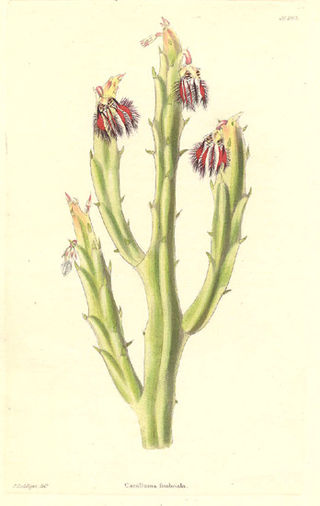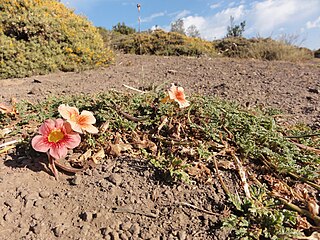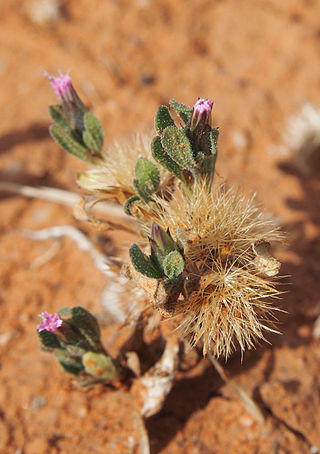
Solanum adscendens, the sonoita nightshade, is a plant native to the Americas. It has been found in Mexico, Costa Rica, El Salvador, Guatemala, Honduras, Nicaragua, Bolivia, Colombia, Ecuador, Paraguay, Corrientes in Argentina, Bahia and Rio Grande do Sul in Brazil, and Texas and Arizona in the United States. In addition, this plant has also been naturalized in parts of Africa.

Ludwigia is a genus of about 82 species of aquatic plants native to Central and South America with a cosmopolitan but mainly tropical distribution.

Harrisia is a genus of night blooming cacti native to Argentina, Paraguay, Brazil, Bolivia, Uruguay, the Greater Antilles, the Bahamas, and the U.S. state of Florida. The genus is named after William Harris, an important botanist of Jamaica. There are about 20 species.

Tragacanth is a natural gum obtained from the dried sap of several species of Middle Eastern legumes of the genus Astragalus, including A. adscendens, A. gummifer, A. brachycalyx, and A. tragacantha. Some of these species are known collectively under the common names "goat's thorn" and "locoweed". The gum is sometimes called Shiraz gum, shiraz, gum elect or gum dragon. The name derives from the Greek words tragos and akantha ("thorn"). Iran is the biggest producer of this gum.

Caralluma is a genus of flowering plants in the family Apocynaceae, consisting of about 120 species.

Caralluma adscendens is a succulent plant in the family Apocynaceae. Its distribution ranges from India and Sri Lanka through the Arabian peninsula to North Africa and the Sahel.
Erigeron adscendens is a species of flowering plant in the family Asteraceae. It is found only in Ecuador. Its natural habitat is subtropical or tropical high-altitude grassland. It is threatened by habitat loss.

Mycena adscendens, commonly known as the frosty bonnet, is a species of fungus in the family Mycenaceae. The fungus produces small white fruit bodies (mushrooms) with caps up to 7.5 mm (0.3 in) in diameter that appear to be dusted with sugar-like granules. Caps are supported by thin, hollow stems up to 20 mm (0.8 in) long, which are set on a disc-like base. Its distribution includes Europe, Turkey and the Pacific coast of the United States. The fruit bodies grow on fallen twigs and other woody debris on the forest floor, including fallen hazel nuts. The variety carpophila is known from Japan. There are several small white Mycena species that are similar in appearance to M. adscendens, some of which can be reliably distinguished only by examining microscopic characteristics.

Rostellularia adscendens is an Australian plant species in the family Acanthaceae. It grows to between 10 and 50 cm high.

Glottiphyllum longum is a species of succulent plant in the family Aizoaceae, native to the Western Cape and Eastern Cape Provinces, South Africa.

Styphelia adscendens, commonly known as golden heath, is a species of flowering plant in the heath family Ericaceae and is endemic to south-eastern Australia. It is a prostrate or low-lying shrub with lance-shaped leaves and cream-coloured, pale yellowish-green or reddish flowers arranged singly or in paris in leaf axils.

Argylia is a genus of flowering plants that is a member of the family Bignoniaceae.

Melicope adscendens is a rare species of flowering plant in the citrus family known by the common name auwahi melicope. It is endemic to Hawaii, where it is known only from the island of Maui. It is a federally listed endangered species of the United States. Like other Hawaiian Melicope, this species is known as alani.

Tecomeae is a tribe with 44 genera of trees, shrubs, and vines in the family Bignoniaceae.
Cosmopterix margaritae is a moth of the family Cosmopterigidae. It is found from the island of Kyushu in Japan and from Taiwan.

Argylia uspallatensis is a species of perennial plant in the family Bignoniaceae. It is found in Chile and Argentina.

Argylia radiata is a species of perennial plant in the family Bignoniaceae. It is found in Brazil, Chile, and Peru.

Ludwigia adscendens, the water primrose, is a species of flowering plant in the evening primrose family. Its native distribution is unclear. It is now a common weed of rice paddies in Asia and occurs also in Australia and Africa, but may have originated in South America.

Serruria adscendens is a species of flowering plant in the family Proteaceae, endemic to South Africa.

Streptoglossa adscendens, commonly known as desert daisy, is a species of flowering plant in the family Asteraceae and grows in all mainland states of Australia with the exception of Victoria. It is a ground cover, upright or ascending perennial or annual herb with purple or pink flowers.


















